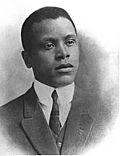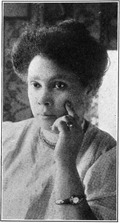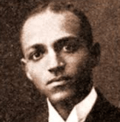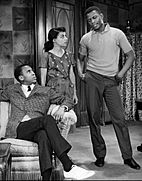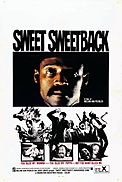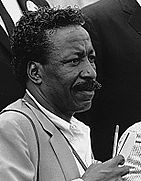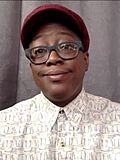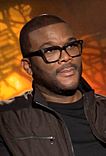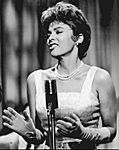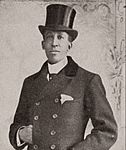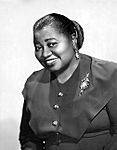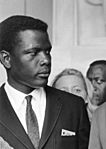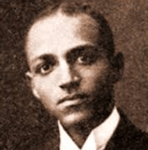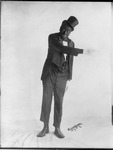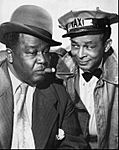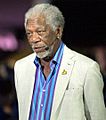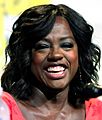African American cinema facts for kids
African American cinema means movies made by, for, or about Black Americans. For a long time, these films often had Black actors and were shown to Black audiences. Sometimes, the people who made the movies, like the directors and producers, were also Black.
Today, many movies feature Black stories and actors, even if the cast is from different backgrounds. These films still show important parts of Black American life.
From the very beginning, Black American cinema has faced challenges. These include unfair treatment, old-fashioned ideas, and harmful stereotypes. Early on, big movie studios used Black actors to attract Black viewers. But they often gave them small roles, like maids or servants.
Black filmmakers, producers, and critics worked hard to change these unfair portrayals. As early as 1909, Lester A. Walton, a writer for New York Age newspaper, spoke out. He said that negative portrayals of Black people in movies hurt everyone. He believed movies could help people understand each other better.
From 1915 to the mid-1950s, "race films" tried to fight racism. They aimed to show Black people in a positive light and educate audiences. This changed in the 1960s and 70s with Blaxploitation films. Even though these films sometimes used stereotypes, they were also praised. They showed Black people as heroes in their own stories.
By the 1980s, directors like Spike Lee and John Singleton made movies with more complex Black characters. This paved the way for filmmakers like Jordan Peele and Ava DuVernay. They use different movie styles, like horror or history, to show many sides of Black life. Ryan Coogler's 2018 superhero film Black Panther was also highly praised. It created a powerful and proud Black world.
Contents
The Start of Black Cinema
The short film Something Good – Negro Kiss was made in 1898. Early movies often showed minstrel shows, where white actors wore blackface makeup. Later, vaudeville acts became more popular.
An African American actor appeared in a story film by 1909. That same year, Siegmund Lubin made a comedy series with a Black cast. Before this, white actors often played Black roles in blackface. Sam Lucas was the first Black actor to have a main role in a major film. He appeared in the 1914 movie Uncle Tom's Cabin.
The Peter P. Jones Film Company started in Chicago. They filmed vaudeville acts and a big event called the National Half Century Exposition. William D. Foster's The Foster Photoplay Company in Chicago was one of the first studios to feature African Americans.
Other theater groups like the Lafayette Players also had actors who moved into filmmaking. REOL Productions was a New York City studio in the early 1920s. They made documentaries, comedies, and a feature film with actors from the Lafayette Players.
The Lincoln Motion Picture Company started in Nebraska and moved to Los Angeles. They were among the first Black producers of African-American films. Their goal was to "encourage black pride" with family-friendly movies.
The white-owned Ebony Film Corporation started in 1915. But their movies used many stereotypes, which angered Black audiences. This was especially true after the controversial film The Birth of a Nation. The company closed in 1919. Norman Studios, founded in 1920 in Florida, made dramas with Black actors. The owner, Norman, was white, but his films were successful from 1920 to 1928.
Biograph made comedy shorts with the famous comedian Bert Williams.
Early Documentaries (1909–1913)
Some of the first African American films were called "Uplift Cinema." This name came from Booker T. Washington's movement to help Black people improve their lives. His college, Tuskegee Institute, made short documentaries. These films promoted the school and gained support.
Their first film was A Trip to Tuskegee (1909), followed by A Day at Tuskegee (1913). That same year, Hampton Institute made its own documentary. It was called John Henry at Hampton: A Kind of Student Who Makes Good. This film aimed to attract donations from people in the North.
Race Films (1915–1950s)
From 1915 to the 1950s, Black production companies worked with independent film companies. They created "race films." These movies had Black actors and were made for Black audiences, especially in the South. They were made with much smaller budgets than Hollywood films.
Race films often showed themes of self-improvement and positive values. They helped create a "Black cinema" in America. Black directors could raise money, film, edit, and score their own movies. Nearly 500 race films were made in the U.S. between 1915 and 1952. Most were shown in the southeastern U.S., where more theaters served Black Americans.
Early stars included future Oscar winner Hattie McDaniel and actor Paul Robeson. Robeson was later put on a list of banned artists during the McCarthy era. Novelist Oscar Micheaux turned one of his books into his first film, The Homesteader, in 1919. This is seen as one of the earliest race films.
Micheaux's second film, Within Our Gates (1920), was a response to the racism in The Birth of a Nation. Micheaux went on to write, produce, and direct 44 feature films between 1919 and 1948. He is known as one of the most productive independent filmmakers in American cinema.
Talkies and Musicals (1920s–1940s)
Early filmmakers often did many jobs, like acting, directing, and producing. Spencer Williams, who later starred in Amos 'n' Andy, wrote and directed films. His company, Amegro Films, made the 1941 film The Blood of Jesus.

Oscar Micheaux worked in silent films and later became a famous director and producer of "talkies" (movies with sound). William D. Alexander also became an important Black filmmaker. He was known for newsreels made for Black audiences.
Major movie distributors included Toddy Pictures Corporation. They bought old films and re-released them with new titles. Million Dollar Productions briefly partnered with Black star Ralph Cooper.
Musical films, called soundies, showed many Black performers. These were like early music videos, made between 1940 and 1946. They featured different music styles and performers, both white and Black. These included singer Dorothy Dandridge, who later became the first Black Oscar nominee.
Comic actor Stepin Fetchit was the first Black actor to earn a million dollars. He is controversial for his roles that showed Black people as subservient. Jazz trumpeter Louis Armstrong also made soundies. He went on to make 20 feature films.
Other Black actors famous for singing and dancing include tap dancer Bill "Bojangles" Robinson. He also performed in Shirley Temple films. Singer and actress Lena Horne was known for her song "Stormy Weather." She was also the first Black actress to sign a contract with a major studio. Hattie McDaniel won an Oscar for her role in the 1939 film Gone with the Wind.
Civil Rights Era Films
First Black Movie Star (1950s–1970s)
In the 1950s and 60s, Sidney Poitier became the first Black movie star. He was the first Black male actor to win an Oscar in a main acting category. He won for Lilies of the Field (1963). He also starred in other famous films like The Defiant Ones (1958), which focused on racial harmony.
In In the Heat of the Night (1967), he played a detective who works with a prejudiced white police chief. Poitier famously slaps the chief in the film. He also starred in Guess Who's Coming to Dinner? (1967), a hit movie about a white woman bringing her Black fiancé home to her liberal parents. In the early 70s, Poitier started directing. He later returned to acting to play important figures like Thurgood Marshall and Nelson Mandela. In 2009, Poitier received the U.S. Presidential Medal of Freedom.
Blaxploitation Films (1971–1979)
Blaxploitation films were a type of low-budget movie made to make money quickly. They aimed to tell Black stories with Black actors for Black audiences. However, they were usually not produced by Black filmmakers. Junius Griffin of the NAACP said in 1972 that these films mostly made money for white producers.
These films were also seen as using too many stereotypes. They often took place in city areas. Black characters frequently fought against "The Man," meaning white oppressors. Violence was also common. Despite these issues, Blaxploitation films were important. They showed Black people as heroes in their own stories. They were also the first movies to feature funk and soul music on their soundtracks.
Two films from 1971 are said to have started the genre:
- Melvin Van Peebles' Sweet Sweetback's Baadasssss Song, about a poor Black man running from the police. It had music by Earth, Wind & Fire.
- Director Gordon Parks' crime film Shaft. Its theme song won an Academy Award and became very famous.
If Van Peebles and Parks made the most important films, then Pam Grier was the most important actress. Director Quentin Tarantino later called her cinema's first female action star. Grier was a key actress in films like Beyond the Valley of the Dolls (1970), Scream Blacula Scream (1973), and Coffy (1973). In Coffy, she played a nurse seeking revenge.
L.A. Rebellion (1960s–1980s)

The L.A. Rebellion was a group of young African and African-American filmmakers. They studied at UCLA Film School from the late 1960s to the late 1980s. They made independent Black art films that offered a different style from typical Hollywood movies.
Their films often featured working-class people from communities in need. Charles Burnett's 1978 film Killer of Sheep is a famous example. Julie Dash's Daughters of the Dust (1991) was the first full-length movie directed by a Black woman to be shown across the country.
The L.A. Rebellion started after events like the 1965 Watts riots. The filmmakers wanted to tell stories based on real experiences. They were against Hollywood's usual way of making movies. Their films were inspired by anti-colonial movements around the world.
Even though many of these films were not widely seen at first, interest in them has grown. There have been special showings and a book about the movement.
Modern Black Cinema
Popular Films (1980s)

In the 1980s, many Black films were comedies. This launched Eddie Murphy's hugely successful film career. In 1987, actor and director Robert Townsend's film Hollywood Shuffle made fun of how Hollywood treated African Americans.
Eddie Murphy made the comedy 48 Hrs in 1982. In 1983, he had another hit with Trading Places. By 1984, Murphy left Saturday Night Live and became a full-time movie star. His first solo lead role was in Beverly Hills Cop, which had two sequels. He also made the romantic comedy Coming to America (1988) and the crime comedy-drama Harlem Nights (1989). In Harlem Nights, he starred with comedy legends Richard Pryor and Redd Foxx.
In 1984, Prince's musical drama Purple Rain made him a superstar. Its soundtrack won an Oscar. In 1986, Spike Lee's black-and-white comedy She's Gotta Have It started his long career. This film was later made into a TV series. Lee ended the decade with Do the Right Thing (1989). This movie explored racial tension and violence, earning him much praise. It is still one of his most famous films.
First Black Matinee Idol (1980s-2000s)
The late 1980s also saw the rise of actor Denzel Washington. He played political activist Steve Biko in Cry Freedom (1987). He also played Malcolm X in Spike Lee's 1992 film Malcolm X. Washington won an Oscar for Best Supporting Actor in Glory (1989). He later won a second Oscar in 2001 for playing a corrupt detective in Training Day.
In 2020, The New York Times called him the greatest actor of the twenty-first century. In 2002, Washington directed his first film, Antwone Fisher. He also directed The Great Debaters (2007) and Fences (2016). Fences, which he also starred in, was nominated for Best Picture at the Oscars.
Breakthrough Years (1990s)
The late 1980s and 1990s were a big time for Black filmmakers. Films like Spike Lee's Do the Right Thing and John Singleton's Boyz N the Hood led the way. The 1990s saw many films by Black directors that changed how people saw "black aesthetics." These movies continue to inspire filmmakers today.
Important films from this time include:
- John Singleton's Boyz N the Hood (1991), which showed the challenges of city life.
- Julie Dash's Daughters of the Dust (1991), about three generations of Gullah women.
- Kasi Lemmons' Eve's Bayou (1997), about family secrets.
- Cheryl Dunye's Watermelon Woman (1996), a romantic comedy-drama.
Many also praise Spike Lee's Malcolm X (1992) as a powerful and honest biography. It started with a video of the police beating of Rodney King, which led to the 1992 Los Angeles riots.
Directors and Oscars (2000s–Present)
Spike Lee continues to make films mostly with Black casts. His movies often explore social and political topics. These range from women's freedom in She's Gotta Have It (1986) to hate groups in the Oscar-winning Black Kkklansman (2018).
Other modern filmmakers use hidden political messages. Jordan Peele's horror film Get Out (2017) was seen as a story about a scary Black future. Ryan Coogler's Black Panther (2018) was seen as a model of a perfect Black society.
Black women and Black gay and lesbian women have also made progress directing films. Examples include Radha Blank's comedy The 40-Year-Old Version (2020) and Ava DuVernay's fantasy film A Wrinkle in Time. Angela Robinson directed the short film D.E.B.S. (2003), which became a feature film in 2004.
Director Tim Story is known for comedies like Barbershop (2002) and the superhero film Fantastic Four (2005). He has been nominated for two NAACP Image Awards for directing.
Hollywood South
In the early 2000s, filmmaker Tyler Perry began making many movies. Critics often don't like his films, but audiences love them. His movies are mostly comedies for Black audiences. He has built a loyal following and his own movie studio in Atlanta.
Forbes magazine called Tyler Perry a billionaire who changed show business forever. In 2007, the film industry spent $93 million on productions in Georgia. By 2016, it spent over $2 billion, partly thanks to Perry. He received the Jean Hersholt Humanitarian Award at the 2021 Oscars. This award recognized his kindness and cleverness, including creating a "Camp Quarantine" to keep people working during the pandemic.
Gallery of pioneers
(Selection was limited by availability.)
-
Dorothy Dandridge (1922–1965), pictured in 1962, is the first Black Best Actress Oscar nominee for her role in 1954's Carmen Jones with Harry Belafonte.
-
Herb Jeffries (1913–2014), pictured in 1944, debuted in 1937's Harlem on the Prairie, as the first Black singing cowboy in the first Black Western talkie with an all-Black cast.
-
Sam Lucas (1848–1916), pictured in 1902, was the first Black man to portray the role of Uncle Tom on stage and screen.
-
Hattie McDaniel (1893–1952), pictured in 1939, was the first Black individual and the first woman to win the Oscar for her role in Gone with the Wind.
-
Oscar Micheaux (1884–1951) was both writer, director and the first major Black filmmaker who made more than 40 films, including adaptations from his own novels.
-
Stepin Fetchit, né Lincoln Perry (1902–1985), pictured in 1959, both criticized as a stereotype and praised as an archetype, was the first Black actor to earn $1 million,.
-
Sidney Poitier (1927–2022), pictured in 1963, was the first Black movie star and the first Black male winner of the Academy Award for Best Actor in 1964.
-
Bill "Bojangles" Robinson (1878–1949), pictured in 1946, was an American tap dancer, actor, singer, perhaps best known today for his Shirley Temple films. For the first half of the 20th century, however, he was the most highly paid Black American entertainer in America.
-
Lester Walton (1882–1965) was a journalist, sportswriter, civil rights activist, diplomat, composer and theater owner But it's his writing on Black representation in film that made him one of African America's earliest and most influential critics.
-
Bert Williams (1874–1922), pictured in 1922, the comedian, one of the most popular of his era, is credited as the first Black man to have the leading role in a film, in this case, Darktown Jubilee in 1914.
-
Spencer Williams (1893–1969) was a groundbreaking actor-director-filmmaker. He portrayed Andy on the Amos 'n' Andy TV show (Alvin Childress is pictured with him above in 1952). He also directed the 1941 race film The Blood of Jesus.
-
Maria P. Williams (1866–1932) was a teacher, reporter, actor and screenwriter, but she is also credited as the first Black woman film producer for the five-reel silent criminal drama based on her own screenplay, Flames of Wrath in 1923.
Gallery of Oscar winners
(Selection was limited by availability.)
- Actors
-
Comedian, actress and EGOT winner Whoopi Goldberg in 2008
- Directors
-
Director and Academy Award winner Barry Jenkins in 2009
-
Academy Award-winning filmmaker Spike Lee in 2012
-
Director and Academy Award winner Steve McQueen at the Oscars in 2014
-
Director and Academy Award winner Jordan Peele in 2019
- Writers
-
Writer and Academy Award winner Geoffrey Fletcher in 2010
Theorists, critics and historians
Film critics
- Tony Langston at the Chicago Defender (1920s era)
- Sylvester Russell at the Indianapolis Freeman (192os era)
- D. Ireland Thomas (1875–1955)
- Lester A. Walton (1882–1965) at The New York Age)
Academics and authors
- Donald Bogle (1944–present)
- Thomas Cripps (1932–2018)
- Phyllis R. Klotman (1924–2015)
- Audrey Thomas McCluskey (1940s?–present)
Archives and collections
In the 1980s, G. William Jones helped restore early African American films. Southern Methodist University has a collection named for him. Kino Lorber produced the Pioneers of African-American Cinema (2015) box set. Other important collections include:
- Black Film Archive: Black films from 1915 to 1979
- The Library of Congress has African American films in its collection.
- The Lucas Museum has acquired a collection of Black Films.
- Pioneers of African-American Cinema (2015)
- The National Museum of African American History and Culture has film posters and photos.
- WUA University has an international collection with many American films.


